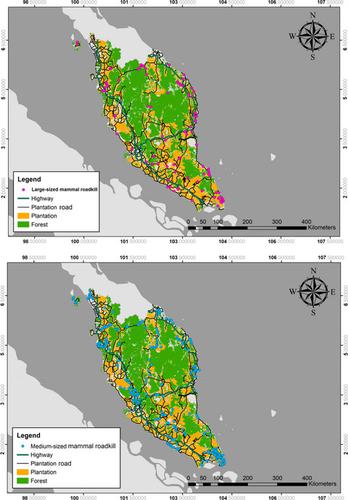当前位置:
X-MOL 学术
›
Ecol. Evol.
›
论文详情
Our official English website, www.x-mol.net, welcomes your feedback! (Note: you will need to create a separate account there.)
Higher mortality rates for large‐ and medium‐sized mammals on plantation roads compared to highways in Peninsular Malaysia
Ecology and Evolution ( IF 2.6 ) Pub Date : 2020-10-16 , DOI: 10.1002/ece3.6827 Jamaluddin Jamhuri 1 , Mohd Anuar Edinoor 2 , Norizah Kamarudin 1 , Alex M. Lechner 3, 4 , Adham Ashton‐Butt 5, 6 , Badrul Azhar 1, 7
Ecology and Evolution ( IF 2.6 ) Pub Date : 2020-10-16 , DOI: 10.1002/ece3.6827 Jamaluddin Jamhuri 1 , Mohd Anuar Edinoor 2 , Norizah Kamarudin 1 , Alex M. Lechner 3, 4 , Adham Ashton‐Butt 5, 6 , Badrul Azhar 1, 7
Affiliation

|
The fragmentation of forests by agricultural expansion, urbanization, and road networks is an ongoing global biodiversity crisis. In Southeast Asia and other tropical regions, wildlife populations are being isolated into pockets of natural habitat surrounded by road networks and monoculture plantations. Mortality from wildlife–vehicle collisions (WVCs) is contributing to a decline in many species of conservation priority in human‐modified landscapes. This study is the first in Malaysia to investigate factors affecting the occurrence of WVCs. We assessed roadkill data gathered by the Department of Wildlife and National Parks on small‐, medium‐, and large‐sized mammals in Peninsular Malaysia. We examined the relationship between wildlife road accidents and several environmental factors. We found a total of 605 roadkill animals, involving 21 species, which included three species classified as Endangered. Road type (plantation road or highway), year, and distance of the road from continuous and fragmented forests were significant in determining mammal mortality. Unexpectedly, the majority of road mortality occurred on palm oil plantation roads compared to highways. Mortality of small‐ and medium‐sized mammals was greater at locations further from continuous forest than those closer to fragmented forests. Segmentation of continuous forest by roads should be avoided wherever possible to reduce the threat of roads on crossing wildlife.
中文翻译:

与马来西亚半岛的公路相比,种植园道路上大中型哺乳动物的死亡率更高
农业扩张,城市化和道路网络造成的森林碎片化是一个持续的全球生物多样性危机。在东南亚和其他热带地区,野生动植物种群被隔离在道路网络和单一种植园所包围的自然栖息地中。野生动物与车辆碰撞(WVC)造成的死亡率正在导致人类修改景观中许多优先保护物种的减少。这项研究是马来西亚首次调查影响WVC发生的因素。我们评估了野生动物和国家公园部收集的关于马来西亚半岛中小型,中型和大型哺乳动物的道路杀伤数据。我们研究了野生动物道路交通事故与几种环境因素之间的关系。我们发现共有605种道路杀伤性动物,涉及21种,其中包括三个濒危物种。道路类型(种植道路或高速公路),年份和道路与连续森林和零散森林的距离对于确定哺乳动物的死亡率具有重要意义。出乎意料的是,与高速公路相比,大多数道路死亡率都发生在棕榈油种植园道路上。在距连片森林较远的地方,中小型哺乳动物的死亡率要高于离破碎森林更近的死亡率。应尽可能避免以道路分割连续森林,以减少道路对穿越野生动植物的威胁。与公路相比,大多数道路死亡率发生在棕榈油种植园道路上。在距连片森林较远的地方,中小型哺乳动物的死亡率要高于离破碎森林更近的死亡率。应尽可能避免通过道路分割连续森林,以减少道路对穿越野生动植物的威胁。与公路相比,大多数道路死亡率发生在棕榈油种植园道路上。在距连片森林较远的地方,中小型哺乳动物的死亡率要高于离破碎森林更近的死亡率。应尽可能避免通过道路分割连续森林,以减少道路对穿越野生动植物的威胁。
更新日期:2020-11-13
中文翻译:

与马来西亚半岛的公路相比,种植园道路上大中型哺乳动物的死亡率更高
农业扩张,城市化和道路网络造成的森林碎片化是一个持续的全球生物多样性危机。在东南亚和其他热带地区,野生动植物种群被隔离在道路网络和单一种植园所包围的自然栖息地中。野生动物与车辆碰撞(WVC)造成的死亡率正在导致人类修改景观中许多优先保护物种的减少。这项研究是马来西亚首次调查影响WVC发生的因素。我们评估了野生动物和国家公园部收集的关于马来西亚半岛中小型,中型和大型哺乳动物的道路杀伤数据。我们研究了野生动物道路交通事故与几种环境因素之间的关系。我们发现共有605种道路杀伤性动物,涉及21种,其中包括三个濒危物种。道路类型(种植道路或高速公路),年份和道路与连续森林和零散森林的距离对于确定哺乳动物的死亡率具有重要意义。出乎意料的是,与高速公路相比,大多数道路死亡率都发生在棕榈油种植园道路上。在距连片森林较远的地方,中小型哺乳动物的死亡率要高于离破碎森林更近的死亡率。应尽可能避免以道路分割连续森林,以减少道路对穿越野生动植物的威胁。与公路相比,大多数道路死亡率发生在棕榈油种植园道路上。在距连片森林较远的地方,中小型哺乳动物的死亡率要高于离破碎森林更近的死亡率。应尽可能避免通过道路分割连续森林,以减少道路对穿越野生动植物的威胁。与公路相比,大多数道路死亡率发生在棕榈油种植园道路上。在距连片森林较远的地方,中小型哺乳动物的死亡率要高于离破碎森林更近的死亡率。应尽可能避免通过道路分割连续森林,以减少道路对穿越野生动植物的威胁。



























 京公网安备 11010802027423号
京公网安备 11010802027423号